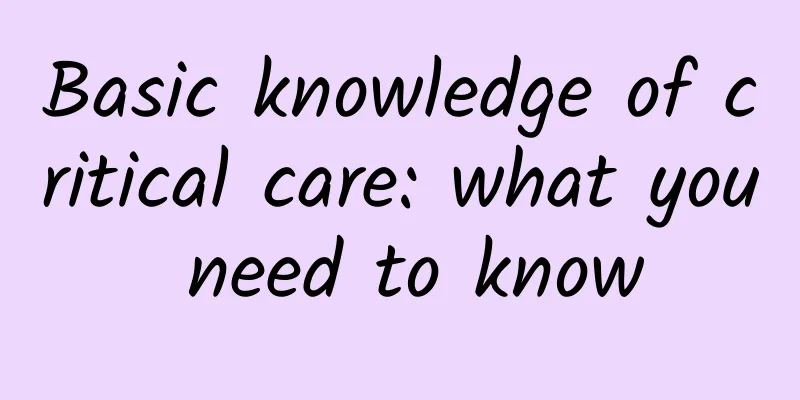Basic knowledge of critical care: what you need to know

|
ICU and emergency department are indispensable and special in hospitals. Many lives are continued here every day, and many are lost here. For every life, medical workers pay a lot just to save more lives, and doing a good job of nursing critically ill patients can help patients relieve pain and save lives to a great extent. Therefore, it is particularly important to master the basic knowledge of critical care. Based on this, the basic knowledge of critical care is popularized below for reference.
1. What are the common symptoms of critical illness? What are the key points to grasp in critical care? Common symptoms of acute and critical illnesses mainly include chest tightness, chest pain, dyspnea, coma, convulsions and shock; in general, the causes of sudden death in critically ill patients are also varied, such as cardiac arrest, acute cardiopulmonary failure, shock and sudden neurogenic death. In the nursing process of critically ill patients, diseases of multiple systems are generally involved. This requires nursing staff to understand the patient's medical history before providing care, so that they can more comprehensively grasp the early signs of the occurrence of critical conditions and the key observation items during the nursing process. A comprehensive understanding of the medical history will help nursing staff master the early identification of critical illnesses and timely disposal methods when symptoms occur, thereby improving the effectiveness of nursing work.
2. How to correctly identify and judge critically ill patients during the nursing process? For the nursing work of critical and severe diseases, nurses need to be able to accurately understand and judge the symptoms of critical and severe diseases, which is the primary task of clinical nursing. In this process, nurses need to judge the severity of the disease at the first time of onset, so as to better provide timely treatment and rescue for patients, improve the rescue rate of critical and severe patients, and reduce medical disputes. In this regard, in this process, timely judgments can be made based on the patient's vital signs to quickly identify whether the patient is in a critical and severe state, including body temperature, pulse, respiration, blood pressure, consciousness, pupils, urine volume, skin and mucous membranes, and other "eight signs" for timely identification and judgment. Among them, the normal body temperature is generally 36-37℃. If it exceeds 37℃, it is a fever and is often infected, while if it is below 35℃, it is systemic failure. At the same time, observe the patient's pulse and auscultate the heart sounds. Under normal circumstances, the pulse beats 60-100 beats/minute and is strong. If HR>100 times/min, fever, hypokalemia, hyperthyroidism, and shock are common, and the pulse rate per unit time is less than the heart rate, which is more common in patients with atrial fibrillation. A thin and weak pulse indicates that the patient is in shock and heart failure. In addition, during the nursing process, it is necessary to promptly explore the patient's breathing condition. Under normal circumstances, it is 16 to 20 times/min with a regular rhythm. In the case of abnormal breathing, there will be abnormal frequency, abnormal rhythm, abnormal depth, dyspnea, and abnormal sound. For blood pressure measurement, normal systolic pressure>90mmHg or mean arterial pressure>70mmHg. Once the blood pressure is lower than this value, it is necessary to consider whether the patient is in shock. In addition, during the nursing process, it is also necessary to observe the patient's consciousness, based on the Glasgow score. Under normal consciousness, the patient can answer fluently and the score is ≥9 points. However, if the patient is confused or drowsy, the patient is likely to fall into a coma, especially critically ill patients, who generally fall into a coma in the late stage of severe illness. If the patient is observed to be irritable and nervous, it means that the patient is in the early stage of shock, which is a kind of consciousness disorder. In this case, the nursing staff needs to strengthen the inspection of hypoxia, heart failure, shock, and increased intracranial pressure. Do not rashly use tranquilizers to calm the patient's anxiety to avoid the risk of direct shock to the patient. Finally, for the care of critically ill patients, it can also be identified and judged from the pupil, urine volume and skin mucosa. Taking pupil observation as an example, the diameter of a normal person's pupil is 2-5 mm and the two sides are equal in size and round. If the patient has a dilated and fixed pupil, it means that the patient is at risk of cardiac arrest. If the pupils are dilated on both sides, it means that the patient is in a state of increased intracranial pressure and dying. By understanding the "eight signs", it is possible to correctly identify and judge the patient's condition in a timely manner, thereby improving the effectiveness of nursing.
3. What should we pay attention to when caring for critically ill patients at night? For critically ill patients, during the period from midnight to early morning, the vagus nerve is excited, the heart rate slows down, the blood flow slows down, the blood viscosity increases, the myocardial contractility weakens, and the bronchial smooth muscle contracts. The changes in the condition are more serious, and the patients are very likely to suffer from sudden symptoms such as heart failure, arrhythmia, asthma and stroke. In addition, compared with the changes in symptoms during the day, the secretion of adrenal cortex hormones in patients at night is relatively reduced, and the body's various reaction abilities and stress abilities are reduced, and the possibility of changes in the condition is greater. Therefore, it is particularly important to observe and care for critically ill patients at night, especially patients with temporarily unknown diagnosis, critically ill patients, cardiovascular diseases and postoperative patients, who should be the focus of night care. By listening to the sound, watching the breathing, watching the changes in body position, and whether there is a coma shock state, etc., the effectiveness of night care can be better improved. In this process, if there are abnormal sounds such as screaming, shouting, sputum sound, or the crying and laughing of mental patients, or the wheezing of bronchial patients and other morbid sounds, it is necessary to check the symptoms in time. Accordingly, during the nighttime observation and care, it is also necessary to observe special patients with angina pectoris, hypertension (snoring, obesity), cor pulmonale, diabetes, intestinal obstruction, trauma (craniocerebral injury), etc. By strengthening the nighttime care of critically ill patients, it is possible to detect abnormal conditions of patients early, and provide timely treatment and rescue. 2. What are the common nursing methods for critically ill patients? The care of critically ill patients is mostly based on the patient's vital signs. For example, if the patient has difficulty breathing, the patient needs to be seated and the airway opened immediately to provide the patient with effective oxygen to prevent the patient from going into shock due to lack of oxygen. If the patient has severe bleeding, fluid expansion is required quickly, and intravenous access is established to stop the bleeding immediately and completely. In addition, when caring for patients in a coma, the airway needs to be opened in time to allow the patient to maintain effective oxygen inhalation, so as to establish intravenous access. Finally, if the patient is in a dying state, it is necessary to call for help immediately, keep the patient in a supine position, perform timely rescue with manual cardiopulmonary resuscitation, and resuscitate with electric defibrillation plus drugs, so as to better rescue and care for the patient. Conclusion To sum up, critical care is a high-risk care. During the nursing process, timely identification and judgment of the severity of the disease through the "eight signs" of the patient's body temperature, pulse, respiration, blood pressure, consciousness, pupil, urine volume, skin and mucous membranes, and good night care, timely care and rescue treatment are provided for different onset situations, which can better improve the nursing effect. |
Recommend
What are the benefits of eating pork liver during menstruation?
Women during menstruation not only have low physi...
If metformin is not effective in controlling blood sugar, GLP-1 receptor agonists can be used to protect cardiovascular
A friend who suffers from diabetes left a message...
How to detoxify when you have acne caused by excessive internal heat
One of the key reasons why beauties get acne on t...
How to cook a roadside barbecue? Is it toxic to cook with gas?
Gas cannot be used for barbecue, whether it is pi...
Causes of stomach pain in girls
We always use the word "flower season" ...
Why does Nephrology Department need to perform fundus examination?
As the saying goes, "eyes are windows to the...
Treatment of lumps on the labia majora
A lump on the labia will affect our normal urinat...
Should I protect my baby if I have polyp bleeding during pregnancy?
If a pregnant woman experiences cyst bleeding dur...
Can Guipi Pills be taken during menstruation?
Guipi Pills are a Chinese patent granule composed...
Backuplify: Social Network Economics, What is Your Data Worth?
Social networks continue to develop at an unstopp...
Can I do vaginal ultrasound during menstruation?
Going to the hospital for regular gynecological e...
Can I eat chocolate during menstruation? Why?
Female friends need to pay close attention to the...
What is the story behind the origin of the marathon? Marathon distance
Marathon has become a mainstream sport. Whether i...
What causes pain in the inner breast?
What is the cause of pain in the inner side of th...
11-year-old girl's menstrual symptoms
The physical development of girls is a gradual pr...









